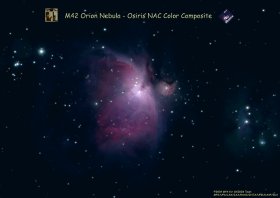
|
Science Highlight December 2004
|
 |

|
Science Highlight December 2004
|
 |
 In March 2004 ESA launched the Rosetta spacecraft. After a 10 year
voyage it will reach comet Churyumov-Gerasimenko in 2014. On board is
the scientific camera system OSIRIS which was built by a European
consortium led by the MPS. It consists of a Wide Angle Camera and a
Narrow Angle Camera. On 28 September 2004 the Orion nebula was imaged
during the in-flight calibration of the instrument. The picture shown
is a composite of exposures obtained with the Narrow Angle Camera in
the blue (480 nm), green (540 nm) and orange (650 nm) spectral range.
In March 2004 ESA launched the Rosetta spacecraft. After a 10 year
voyage it will reach comet Churyumov-Gerasimenko in 2014. On board is
the scientific camera system OSIRIS which was built by a European
consortium led by the MPS. It consists of a Wide Angle Camera and a
Narrow Angle Camera. On 28 September 2004 the Orion nebula was imaged
during the in-flight calibration of the instrument. The picture shown
is a composite of exposures obtained with the Narrow Angle Camera in
the blue (480 nm), green (540 nm) and orange (650 nm) spectral range.
OSIRIS was built by a consortium of the Max-Planck-Institut für Sonnensystemforschung, Lindau, Germany, the University of Padova, Italy, the Laboratoire d' Astrophysique de Marseille, France, the Instituto de Astrofisica de Andalucia, Granada, Spain, the Research and Scientific Support Department of the European Space Agency (ESA/ESTEC), Noordwijk, The Netherlands, the Instituto Nacional de Tecnica Aerospacial, Madrid, Spain, the Universidad Politecnica de Madrid, Spain, the Department of Astronomy and Space Physics of Uppsala University, Sweden, and the Institut für Datentechnik und Kommunikationsnetze, Braunschweig, Germany.
| © 2009, Max Planck Institute for Solar System Research, Lindau |
Küppers 17-12-2004 |